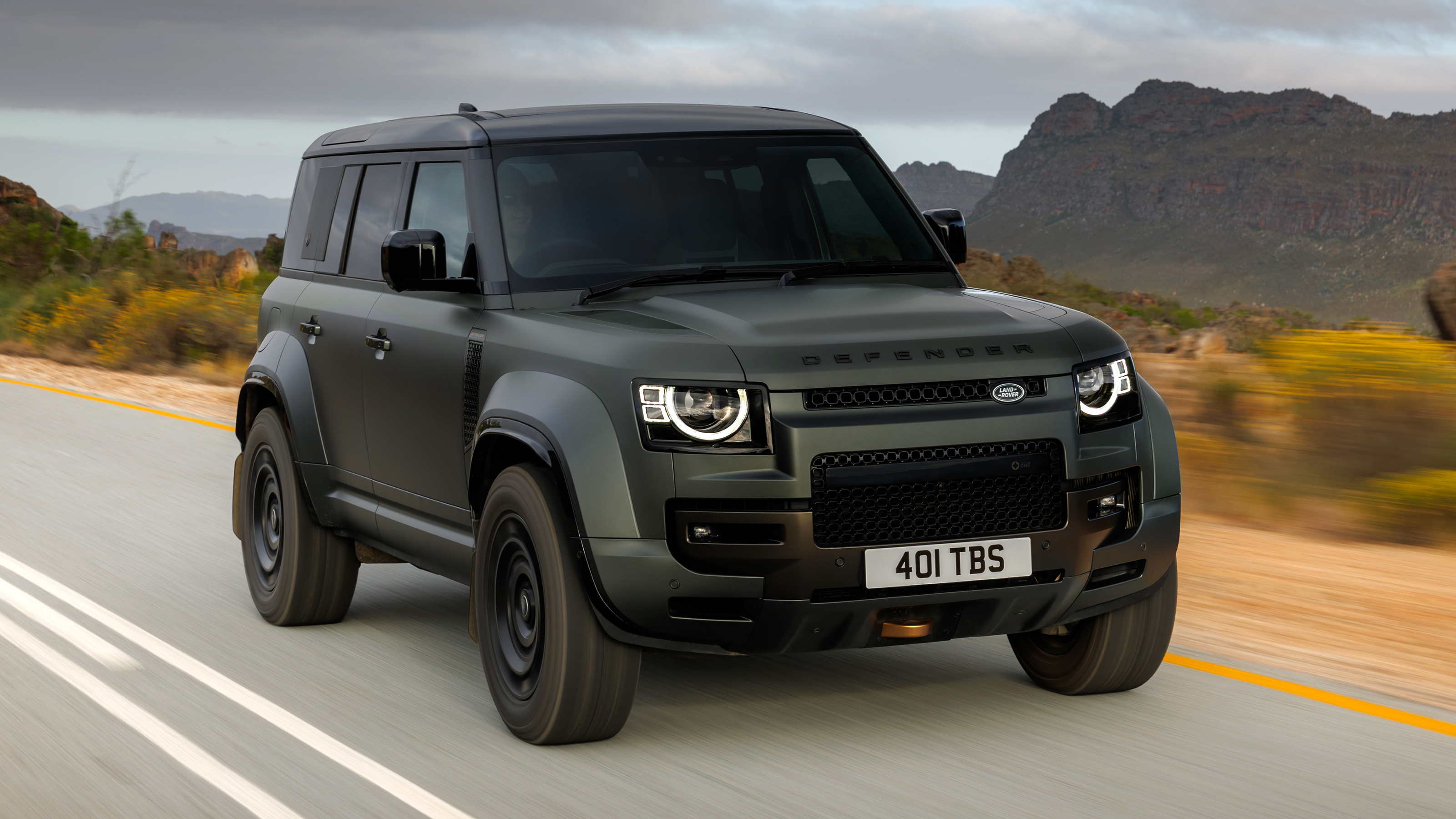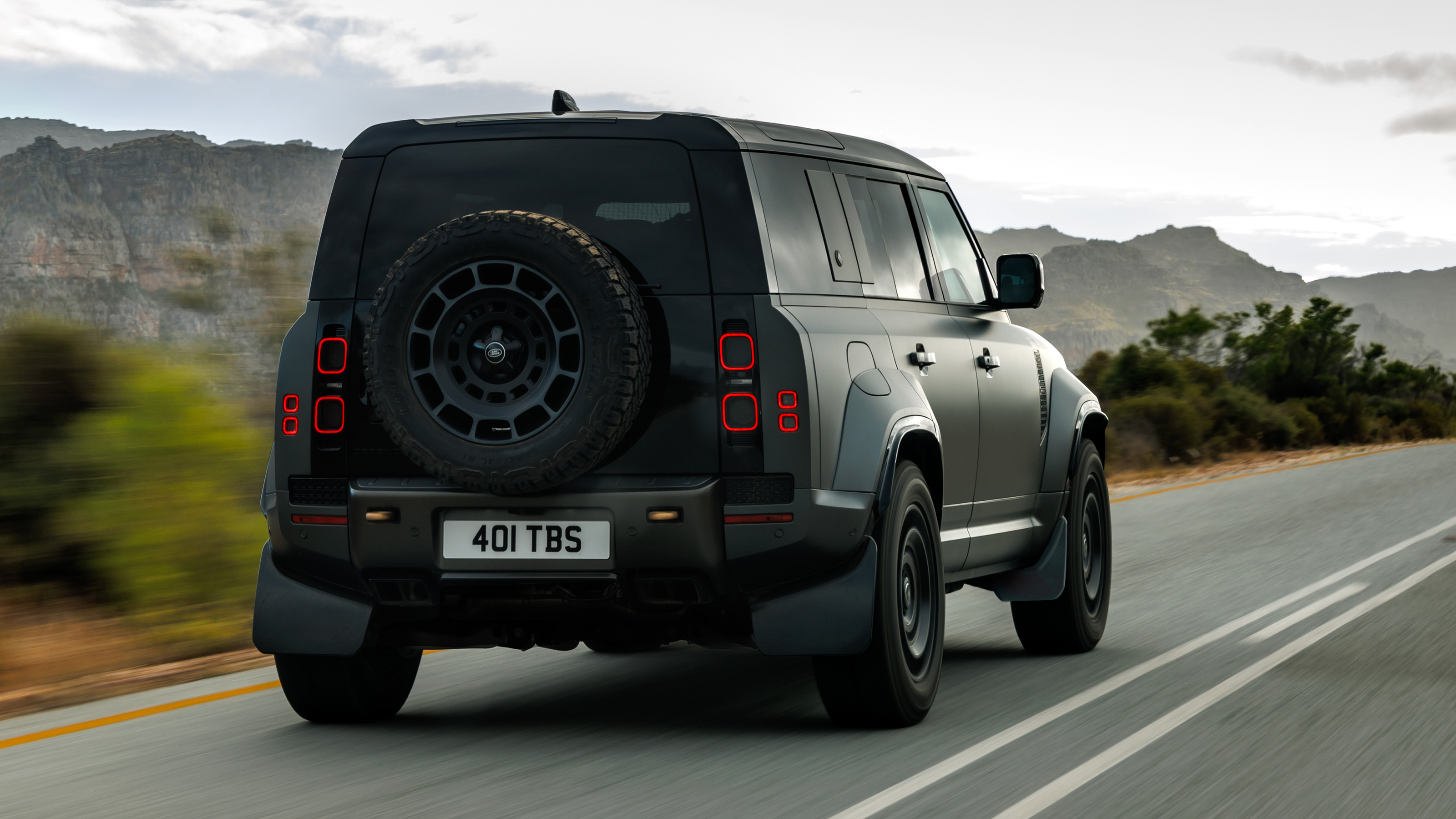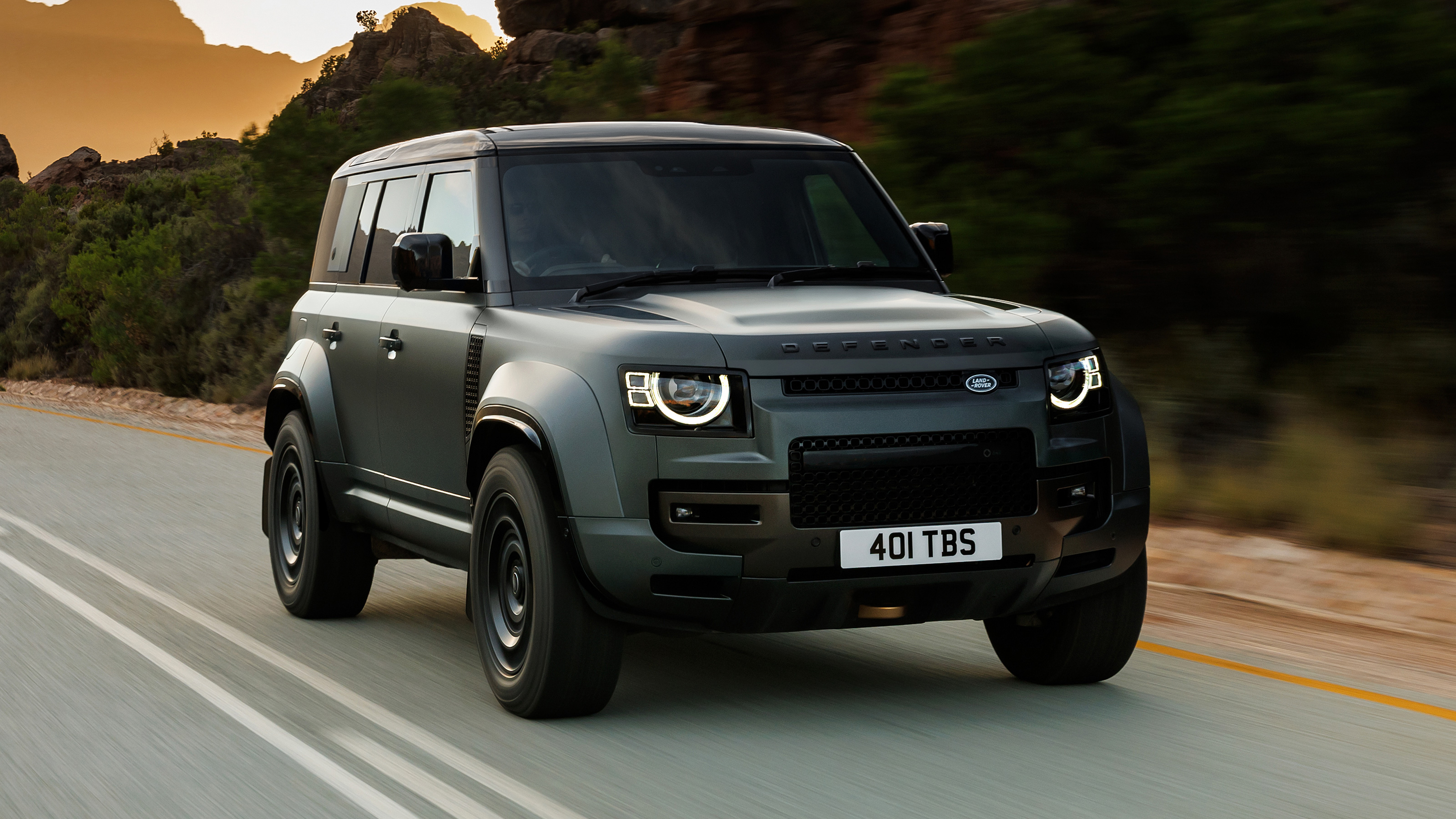
SPEC HIGHLIGHTS
- BHP
626.3bhp
- 0-62
4s
- Max Speed
155Mph
What’s this?
The Land Rover Defender Octa’s mission statement is simple: to be the world’s fastest off-roader. But how do you define that? A Nürburgring lap time is only going to tell part of the story, and this being a Land Rover – though the focus is on individual brands these days – it’s invariably about bandwidth. It’s a dune-bashing, quasi-Dakar rally raider that can double up as a long distance family hauler. It’ll crawl over rocks and wade up rivers but can also drift with hedonistic abandon.
And there’s a hint of triumphalism, too. Since the Defender arrived in 2019, it has proven to be a smash hit. The old Defender, currently enjoying prime screen-time in The Traitors, was shifting 12,000 units per year annually towards the end. The current model shifts that many in a month, far exceeding its maker’s expectations. The LR bit of JLR is in commercial clover.
A fast off-roader, eh. Lots of those around. Can a Land Rove… sorry, Defender really cut it with the tempo raised?
It’s a juicy market segment, no doubt about it. Think Aston Martin DBX, Audi Q8, Bentley Bentayga, Lamborghini Urus S, Mercedes G63, Porsche Cayenne, and more. You might even want to throw the Lamborghini Huracan Sterrato and Porsche 911 Dakar into the mix. Land Rover benchmarked the Defender Octa against the Ford F-150 Raptor so it’s clearly still cleaving to a high degree of functionality.
Whatever the ambition, the Octa is a Defender extensively re-engineered, three years in the making. We’re told that 13,960 additional tests were carried out during its development, on the ’Ring, on Swedish ice, in Dubai, and at Château de Lastours, the latter a punishing rally raid facility and the place Dakar entrants go to test (and occasionally die). The Octa is also the first Defender to conquer every trail at JLR’s famous Eastnor Castle facility.
It arrives costing £160,800 in Edition One form, which includes a new Faroe Green metallic paint finish, a special and more sustainable leather trim inside, and chopped carbon fibre detailing. The regular car costs £145,300.
That’s punchy. What about the name?
Octa takes its inspiration from the diamond, octahedral in shape, equal parts beautiful and of course the toughest mineral on earth. It’s also something LR could register in 175 territories without fear of legal entanglements. We’re not sure what was wrong with SV, but ours is not to reason why.
It’s certainly purposeful looking, but they haven’t gone totally banzai…
True enough. The design team has resisted the temptation to fully “murder out” the Defender, to the point that it’s about as subtle as a big high performance SUV could ever be. In Octa guise, it rides 28mm higher than the regular car and is 68mm wider overall, with muscular wheelarch extensions. As well as that new Faroe Green colourway, there are fresh copper and grey shades. It’s quite military in look and feel, all the more so if the optional matte protective film is present. But we could live without that chopped carbon fibre on the bonnet and inside.
And underneath?
Most of the changes enhance the Defender’s fitness for purpose. The front and rear axles have been moved forwards (by 4mm and 3mm) to fit the bigger tyres and manage the extra ride height. There’s a larger intake at the front to cope with the new engine’s hungrier cooling requirements, and a powder-coated metal undershield for extra protection. The rear gets something similar. An extended bar behind the shield provides cover for a pair of auxiliary radiators, and there’s an undertray made of a tough composite.
Thermal management was key. There’s also a heat shield around the fuel tank and triple insulated fuel lines. In fact, there’s about 20km of piping on this thing. Wheel articulation in its most extreme setting is up 100mm to 500mm, and the Octa’s approach, departure and breakover angles are all improved (40.2, 42.8 and 29 degrees respectively). Not just the fastest Defender by far, this thing has been engineered to go further and to take even more punishment.
Top Gear
Newsletter
Thank you for subscribing to our newsletter. Look out for your regular round-up of news, reviews and offers in your inbox.
Get all the latest news, reviews and exclusives, direct to your inbox.
That’s quite the job description. How does it stack up?
Well, it takes its time revealing itself. Where the old supercharged 5.0-litre V8 was a bit of a party animal, the new and more emissions-friendly BMW-sourced 4.4-litre twin turbo (with mild hybrid) feels quite buttoned-up, in default Comfort mode, anyway. There’s 626bhp and 553lb ft available here but it’s not in your face.
It also receives a number of model-specific modifications, including a reinforced cradle for the transmission and a new oil sump. There are unique propshafts, larger diameter driveshafts and reinforced joints. The engineers have even introduced high-tensile steel in the rear differential because the Octa generates a substantially higher amount of axle torque. The ZF eight-speed ‘box is familiar, mated to a selectable high and low transfer case. The Octa has a bespoke quad-pipe exhaust system whose back pressure has been finessed to optimise performance without hurting its ability to wade. Which, coincidentally, is superior to any previous Defender.
You’re sounding somewhat ambivalent here.
Not exactly. One thing to note is that we’re running on the optional Goodyear DuraTec Advanced All-Terrain rubber. That’s deemed necessary because we’re driving the Octa in South Africa across a variety of terrain, escalating in difficulty. They look suitably chunky on the Octa’s understated new 20in alloy wheel, which also happen to be the largest tyres yet fitted to the Defender. Their three-ply construction improves the strength of the sidewall, but they’re speed restricted to 100mph (112mph in North America).
More significantly, they also compromise on-road handling, though not by much according to JLR’s vehicle attributes guru, former Lotus and Aston Martin man, Matt Becker. Most Octas will end up running the Michelin all-season tyres on 22in alloys. But we’ll have to revisit the car with those fitted so we can report on its ultimate on-road capabilities.
Understood. But what can you determine?
One short push on the rather cheap looking Octa button on the lower part of the steering wheel takes us into Dynamic mode. This perks things up considerably. Steering, throttle, suspension and exhaust note all get more alert and responsive. But the big news here is the 6D dynamics air suspension tech (the name refers to the six degrees of axis a rigid body can move in a 3D space).
Rather than traditional anti-roll bars, the Octa uses hydraulically interlinked, triple valve semi-active dampers that provide independent compression and rebound control. Fluid is sent from dampers on one side of the vehicle to the other, and the same thing happens front to back to eliminate pitch during braking or accelerating. That’s the same sort of tech that McLaren uses in the 750S (and indeed on the Range Rover Sport SV). There are also new control arms, links, and knuckles. They are not messing around.
And how’s that in practice?
While nobody is going to mistake the Octa for a high-end Mac, there’s a suppleness to its ride and a precision to its body movements. It really handles. Head toss is usually an issue in SUVs, but there’s little sign of it here. If you want an exact figure, roll resistance is up 67 per cent compared to the regular car.
On a tightening mountain pass the Octa’s ace card is its noticeably faster steering. It turns in really nicely for such a big machine, if not quite as adroitly as the Aston, Lamborghini or Porsche. But then no-one in their right mind would venture fully off-road in either of those. If you want to change gear using the paddle shift you need to slide the gear selector across into ‘manual’, which is logical but still a little irritating.
Our test takes in lots of challenging surfaces, and it’s possible to maintain a seriously impressive pace on a fast gravel section, getting progressively and amusingly more sideways on tighter turns. For the record, the Octa can hit 62mph in four seconds, and tops out at 155mph on the all-season tyres.
What’s it like off-road?
Better than ever. The Defender’s terrain response makes hardcore off-roading very accessible. One button push selects the low range transmission, another puts it into the appropriate mode (gravel/sand/rocks etc), leaving the active electronically controlled centre and rear differentials to do the heavy lifting. You’ll never enjoy driving so slowly than when you’re confronted by a series of apparently insurmountable boulders. The windscreen is alternately full of blue sky and then hard, unforgiving looking ground. Teetering on the edge of a rock before gently tipping forward, ears alert to expensive graunching sounds, is an odd way to get your jollies. Especially in something with 626bhp.
And that’s just for starters. Now we get to fully engage Octa mode – via one long push on the designated button – and really go for it around an improvised sand track. This is the point where the Defender waves goodbye to those well-bred and more exotic rivals and goes next-level. New software algorithms identify rough surfaces by monitoring suspension movements and the control modules in the dampers and the ABS. The set-up switches automatically between calibrations so that it can deal with loose surfaces.
Sounds like fun…
Hell yeah. With the DSC off, the Octa blasts along the track like a plus-size WRC car, responding to Scandi-flicks with the keenness of something half its size and weight. There are crests and yomps here that would pulverise most things, but it remains supremely unflustered, its damping and wheel articulation always on the money. In fact, the system’s so smart it even knows when you’re airborne and primes the suspension for landing. Talk about being up for it.
It’s equally good on the sand dunes we find in Lambert’s Bay, a slower but even more technical off-roading challenge. The only thing we do here is drop the tyre pressures to 20psi, and remember to maintain momentum without applying too much throttle. That’s when you get stuck, easily done in sand so soft and fickle that one of our on-hand experts reckons it’s the trickiest he’s ever encountered. Land Rover has long talked about breadth of capability. The Defender Octa’s bandwidth is deeply impressive, even if it is answering questions only a tiny proportion of its owners will ever ask.
Has much changed inside?
JLR’s chief creative officer Gerry McGovern loves the idea of ‘materiality’, and there’s lots to love and fondle in a Defender. The dash architecture is wonderfully simple, the touchscreen is easy and intuitive to use, the trim robust but tactile. There’s also more recycled carbon on the centre console. New for Octa are ‘body and soul’ seats which use vibro-acoustic, AI-enabled tech and a quartet of transducers to deliver tactile as well as aural audio. A neat trick, augmented with six wellness programmes that push the idea of the massage seat to the limit.
The seats themselves are also new; they’re seam-free and supremely comfortable. Our car is trimmed in a sustainable Ultrafabric™ that’s much lighter than leather and generates a quarter of the CO2 during production. The central storage compartment is refrigerated and there are USB-C ports all over the place. The Octa is a highly functional bit of kit. The steering wheel is also new, and has translucent, edge-lit paddle shifters. These glow red when Dynamic or Octa mode are selected.
The ultimate Defender, then.
It probably goes a lot further than it needed to. But then that’s a Land Rover USP, right? Pity it’s so expensive, but more than ever this is a car that covers all the bases. Now including fast corners, on and off-road.
Featured

Trending this week
- Car Review
BMW iX3






